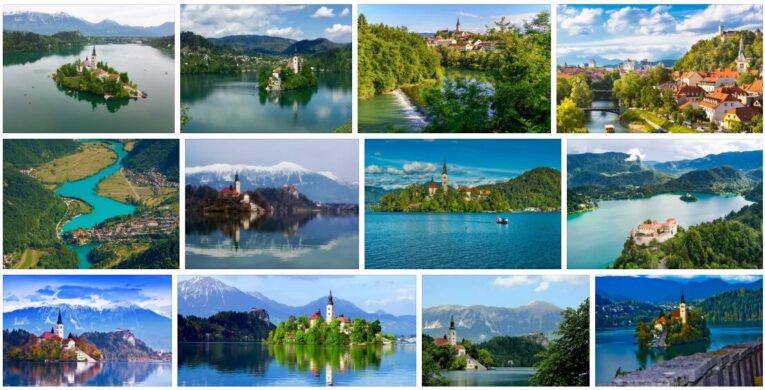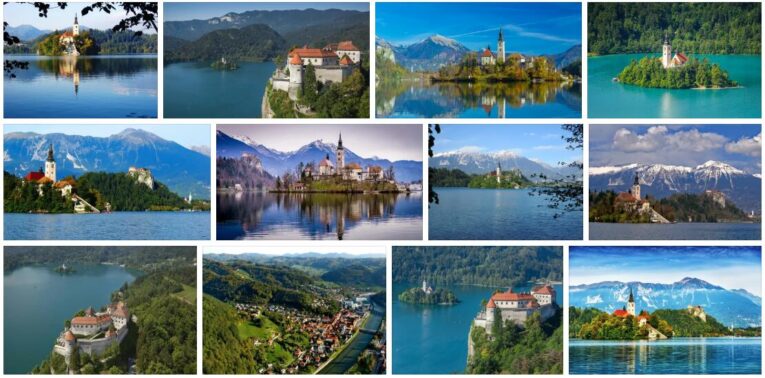Slovenia is one of the successor states of the Socialist Federal Republic of Yugoslavia. The country gained independence when it separated from Yugoslavia in 1991. It has the most uniform population structure among the multiethnic states of Southeast Europe. Most of the residents are Slovenes. Slovenia has the highest standard of living among the formerly socialist countries in Europe. No other of these countries is as well developed and prosperous as Slovenia today. Strict economic reforms have successfully brought about the restructuring. The service sector, especially the areas of trade and transport, is of the greatest importance. Tourism is becoming increasingly important as a source of foreign currency.
Abbreviated as SL by ABBREVIATIONFINDER, Slovenia borders Austria in the north, Hungary in the northeast, Croatia in the east and south and Italy in the west. Slovenia has a share of the Adriatic Sea with a coastline of only 42 km.
Important data about the country
| Surface: | 20 256 km² |
| Residents: | 2 million |
| Population density: | 99 residents / km² |
| Growth of population: | – 0.1% / year |
| Life expectancy: | 76 years |
| State capital: | Ljubljana (Ljubljana) |
| Form of government: | Republic since 1991 |
| Languages: | Slovenian, Croatian, Hungarian, Italian, minority languages |
| Religion: | Christians 74.2%, Muslims 1.5% |
| Climate: | humid cool temperate climate, Mediterranean in the far west |
| Land use: | Arable land 13%, pasture land 37%, forest 45% |
| Economic sectors: (share of employees) |
Agriculture 9.7%, industry 38.6%, services 51.7% |
| Export goods: | Machinery, pharmaceuticals, food, clothing, furniture |
| Gross domestic product: | $ 27,749 million (2003) |
| Gross National Product: | US $ 11,920 / residents (2003) |
Surface shape
Slovenia is predominantly a mountainous country .
It is part of the Southern Limestone Alps with the Karawanken in the north and the Julian Alps in the northwest. Triglav, the highest mountain in the country at 2863 m, is also located in the Julian Alps. To the south, the Alps merge into the classic Karst area of Innerkrain. In the limestone formations of this karst area there are many famous stalactite caves, some of which are UNESCO World Heritage Sites. The karst landscape has only a thin ground cover, from which the bare rock often peeks out. It consists of gray-white limestone, the surface of which is poor in vegetation and heavily covered with gullies and crevices. Although rainfall is abundant, few rivers meander through the area. They disappear from the surface and form underground river systems with caves. There are karst phenomena in all areas with limestone formations. Their characteristic above and below ground appearances (Fig. 3) arise because limestone is permeable to water. It can therefore be dissolved by the water of precipitation and water bodies. Lowlands only exist in Slovenia in the 40 km long coastal strip on the Gulf of Trieste. In the east of the country, hilly lands on both sides of the Drava form the transition to the Pannonian Basin.
Waters
The Sava is the longest river in Slovenia. It rises in the north of the country and flows through Slovenia over a length of 220 km in a south-easterly direction. After a further 720 km it flows into the Danube near Belgrade. Other larger rivers are the Drava and Mur in the east. The countless bodies of water that seep into the karst areas return to the surface of the earth as very heavy karst springs.
Climate
Slovenia has a predominantly humid, cool, temperate climate. Only the extreme west is subject to Mediterranean influences. The average annual rainfall is 1383 mm. Depending on the location, more than 3000 mm of precipitation can fall on the western mountain slopes.
Summers are warm and relatively dry. The main precipitation falls in winter.
Vegetation
About 45% of the country is covered by forests.
In the lower regions of the Alps, these are mainly deciduous forests with beeches. In the higher elevations, coniferous forests with spruce and fir trees dominate. The tree line is around 1800 m.
Oaks and pines thrive on the karst areas, but rarely as a closed forest area.
Economy
Slovenia is one of the six former constituent republics of Yugoslavia and the wealthiest and most economically successful of the former socialist states in Southeast Europe.
Of all these countries, Slovenia has the highest standard of living. Strictly implemented economic reforms after independence have enabled a successful economic transformation.
However, in 1998 around 15% of the country’s working age were unemployed.
The basis of the economic boom is agriculture, efficient industry and tourism.
Agriculture
Of the 40% of the land that can be used for agriculture, two thirds are used as grazing land for cattle breeding and dairy farming.
Maize, wheat, potatoes, sugar beet, but also hops, wine and fruit are grown in the river basins of the Save, Mur and Drava. However, many Slovenes only do agriculture as a sideline.
Industry
Slovenia has a larger number of well-qualified professionals.
They work primarily in metal processing, mechanical engineering, and the electrical and chemical industries. The food and textile industries also have traditional importance.
Tourism, which has become a major source of foreign exchange, is of increasing importance for the country’s economy.
The good transport infrastructure of Slovenia as a transit country is also beneficial for tourism. With a road system of around 20,000 km, the connection to the Tauern motorway to Austria via the Karawanken tunnel and a rail network of around 1,200 km, the country is very accessible.

